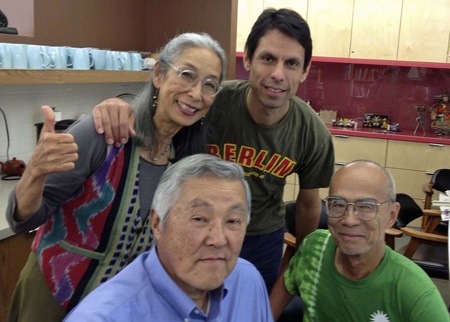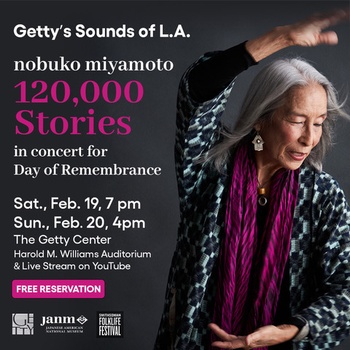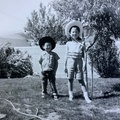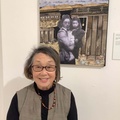On the influence of Reverend Mas Kodani of Senshin Buddhist Temple (in Los Angeles, CA):
I believe one of the most influential people in my art making, actually. But when I came back here to be able to be at Senshin, Rev. Mas just openly gave me the key to the social hall without really knowing me that well. And trusted me. He said, "You could teach dance, you know. You could rehearse here." And that openness and the trust that he had was really shocking. That’s having a lot of faith in a person and we really moved in there! (laughs) And then I had Kamau. Kamau was crawling on the floor and becoming from an infant into a young boy. During my classes and rehearsals and everything like that so, you know, it was a sanctuary for our lives and a place where Kamau could grow up and I could do my work at the same time safely.
But Rev. Mas was truly influential and then this thing of trust. So he trusted to give me the key. Then he also trusted to say, “Write an English obon song.” Well, I didn’t know anything about Japanese music, you know. It’s like how can you trust someone to do a good job when they don’t know what they’re doing? Then he gave me a bunch of Japanese music to listen to, obon music and other music and just trusted that I would come up with something. And I conferred with him, you know, got Japanese words from him and somehow came out with a first song Yoiyo — “just dance.”
And in doing that and in trusting me with that, he was teaching me about Buddhism at the same time. Because I think he really believes that art is a great way to teach Buddhism. That’s why the taiko is such a big part of Senshin and gagaku and bugaku. The act of making music together or creating something together makes you work like a Buddhist. You have to listen, you have to collaborate, you have to work together. And so I always have that example of work at Senshin and how the community worked together, cooked together, did mochi together. I mean these are acts of community that the movement was talking about but it was actualized in the practice of Buddhism in this temple.
The first song Yoiyo, when we did it live with 1,000 people on the plaza of JACCC (Japanese American Cultural & Community Center, in Los Angeles). And I saw 1,000 people dancing from the yagura. I knew what oneness was about. I could feel what oneness is. So these ideas, these abstract ideas, could be computized and experienced in the doing of art. And the doing of the dance, everyone together. It was sort of a magic way of internalizing these (Buddhist) principles. I learned so much and I continue to learn by creating art in this communal way with Rev. Mas on my shoulder.
I wanted to ask about your songwriting partner, Chris Iijima, whom you describe as being as being a gifted poet and musician.
Chris, he grew up in a very political family, very smart and political. His father was a piano player though. His father was also like my father, somebody who loved music. So for Chris, you know, he had both the music side and the political side around the kitchen table. At the same time that Chris was a very smart guy and was very poetic. He was artistic and always listened to music. He had the earphones on all the time: on the subway, reading the paper, he’d always be listening to music.
And so song making is a very, I don’t know if you can really teach a person to write a song. I guess you can, but songwriting is really more about listening and hearing other songs. Then being able to hear a song inside your head before you get it out. It has to come inside your head somehow. And sometimes it comes from nowhere. Like where’d I get that? But Chris had the ability to do that and do it quickly. So when things would happen, he could easily turn it into a song. I would be amazed at how quickly he could do that. So I learned from him even though he was ten years younger than me. I had written a few songs already.
We had a way of singing together that was easy. Our styles just melded together and I knew where he was going with things. And he knew how to use my voice and I knew how to go with his voice and his rhythms really naturally. So that’s how that partnership just sort of (snaps fingers) came out of nowhere, you know. It came out of our work together and just sort of stumbling into writing our first song and then seeing how important it was to our people to have their own song.
Importance of having one’s own song:
And that’s really the premise of the book itself. Of this simple thing, a song. Why is it important for us to have a song? What does a song do to us? And a song that’s about us. White people don’t know what that means because they live with it all the time, they hear songs about love stories and failures and heartache and about their lives. And they see people that look like them sing those songs. But we didn’t have that. Yeah, our ancestors had music and people who looked like them and sounded like they’re familiar. But we were growing up in America. We didn’t have anything that represented that strange place that we were at in between worlds. We were both American and Japanese, but probably more American culturally.
I know that Yuri Kochiyama was a major influence on you.
Yes, she’s like my spiritual mother, you know. She brought me into the movement. And Yuri continued to push the envelope in everything she did. She didn’t compromise her values. She kept following them. So their household was not like a peaceful, quiet place. It was a bustling, it was a center of, a heart center of the movement. And so that was very educational to see another kind of life that, they all were learning all the time, they were getting exposed to LeRoi Jones and, you know, musicians and poets and black, Puerto Rican, and political, and Malcom X was at their house. So you have to learn, you have to learn when you get exposed to people. Your world gets bigger and bigger and bigger.
I saw Yuri at one of her grandkid’s birthday parties and she seemed like just another grandmother.
She was very Japanese American. At the same time she did those other things. It wasn’t like she was running away from her own culture or identity. She just had this other dimension that opened up her life in a different way, you know. She was still a Nisei who took care of her kids and who ironed their clothes and made sure they got up in the morning.
But she was not only influential to me but so many, so many people because she was a connector. Yuri was a connector. So her house was a crossroads in that sense and she was a crossroads. She knew if you did this, and you did this, this is going to create something bigger. Like in the same way that Rev. Mas does stuff like that as well in his own way. These people are connectors who make sparks happen with their ideas.
On Mamie Kirkland:
I want to talk about another person, Mamie Kirkland, Tarabu’s mother, who lived to be 111 years old. For twenty of her last years she lived six months (each year) with us. So she at 107 — when Tarabu took her back to Mississippi, 100 years after she had left Mississippi, to see this place where she feared — said, “I will never go back there because of what happened.” They had to flee Mississippi for fear of their lives. (She had to) go back there to this place that she said, “I don’t want to see it on a map!”
He (Tarabu) said I want to go back there and I want to take my mother back there because this is one of the worst lynchings recorded. 10,000 people witnessed this lynching. So he convinced her to go back. She didn’t want to at first, but we took her right after her 107th birthday. She left there when she was 7. Imagine her birthday party and the next day we took her to Mississippi.
And we went and we found the spot where this guy was lynched. And people from Equal Justice Initiative, this group in Alabama that has been studying and keeping track of these lynchings and the stories of people who have been affected by lynchings, came to interview her. And then Tarabu made a film about this and called it 100 years from Mississippi.
But through this experience and talking about this story, that she had kept with her all these 100 years, she realized that there was a reason she was still living. That it was time for her to tell her story herself, to the world. And so at 107 until 110 — she died when she was 111 — but in those three years she was able to travel to New York and to speak to people. And to Alabama to be honored by the Equal Justice Initiative. She’s part of the museum that they have there.
And in February, for African American month, the film is going to be showing there at the Lynching Museum in Montgomery, Alabama. Tarabu’s going to go back there and introduce the film. So she’s another one, you know, she was funny and had a lot of wisdom and love. After all she had gone through she still had a lot of love and wisdom. So it was really an honor to be able to care for her these years. Another great woman in my life!
* * * * *
Nobuko Miyamoto will perform at “Sounds of L.A.: 120,000 STORIES with Nobuko Miyamoto and Guests” for Day of Rememberance at Getty Center on Saturday February 19 & 20. 2022 at 7pm. Admission is free, but an advance ticket is required. For more information, please check here.
© 2022 Edna Horiuchi








